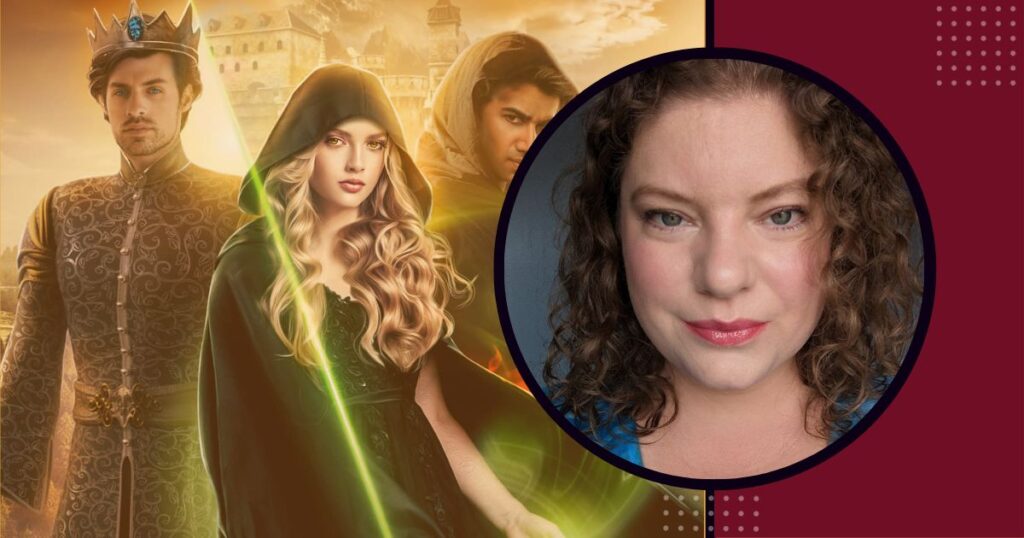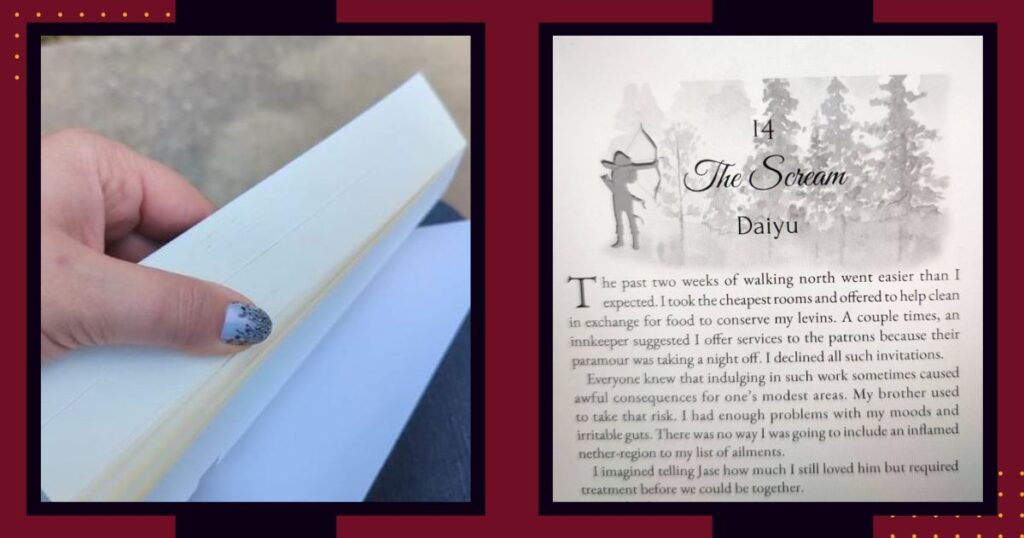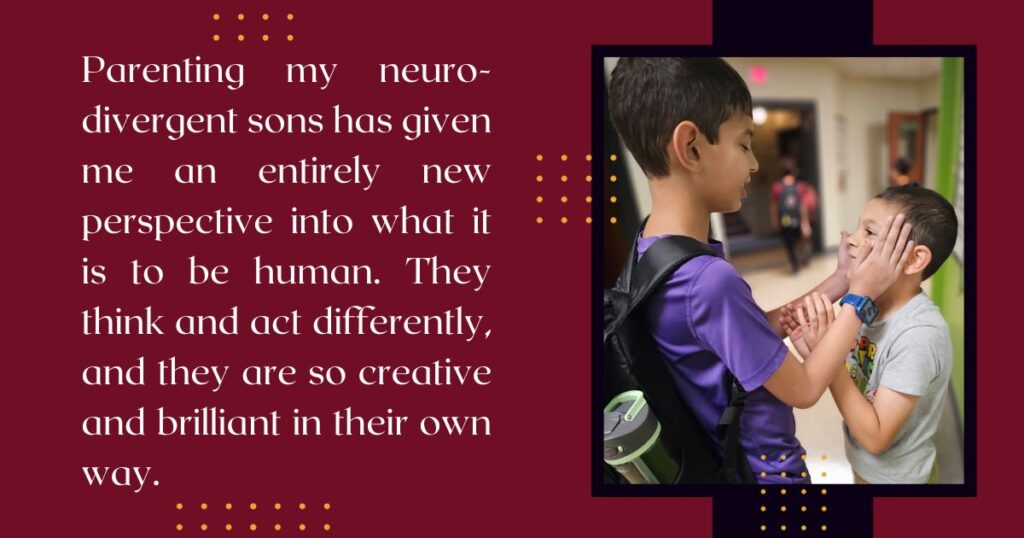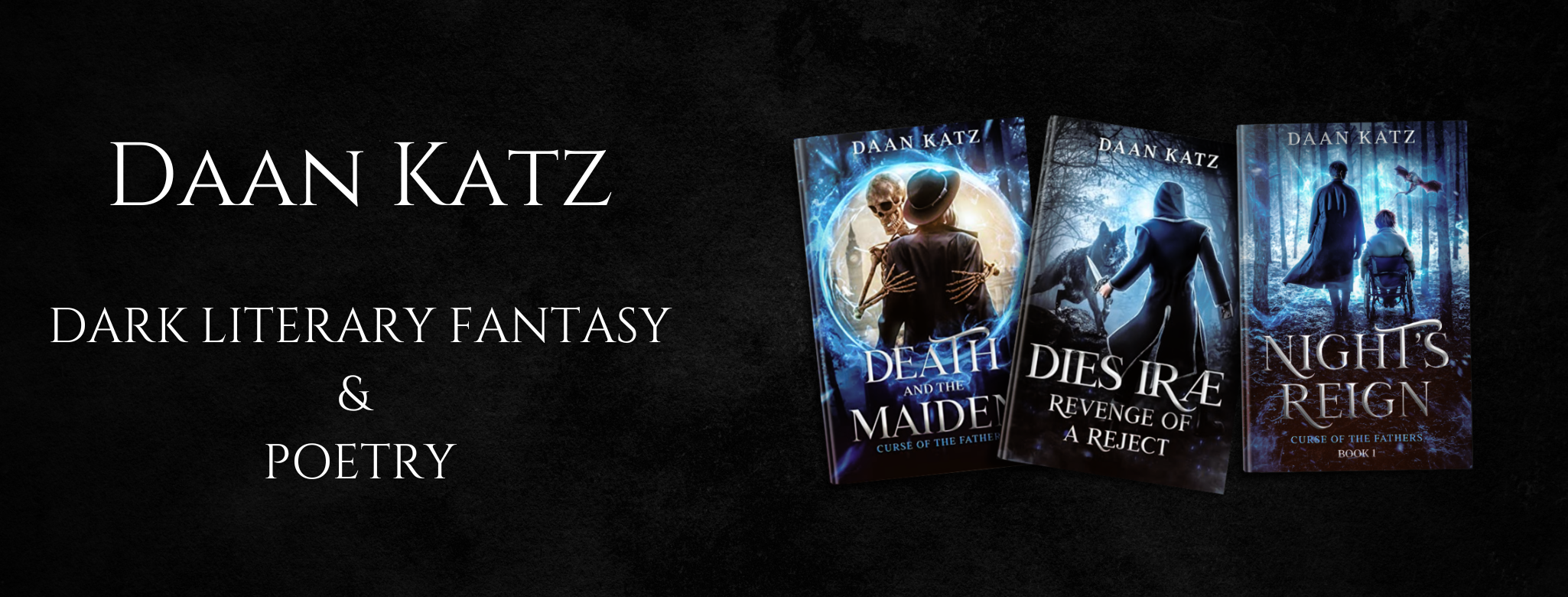I’m thrilled to share this awesome interview with Sarah Emmer, where we chat about her upcoming novel “Dissonance”.
Table of Contents
Title and Genre of Featured Book
Dissonance, Romantic Fantasy

Short Author Bio
I’m a former HR generalist who is passionate about diversity and inclusion in the workplace and in fiction. I’m in a happy interracial marriage and a mom of two neurodivergent kiddos. Fantasy is my escape from the real world, where I can weave stories full of hope and life for everyone.

Elevator Pitch for Dissonance
Dissonance is a time travel romantic fantasy with dark themes. But hope lies beneath everything.
Back Cover Text of Dissonance
End the Dissonance. Restart the Timeline.
Nirel and Jase escape, but arrive in the past injured and far from their destination. A new mission emerges: rescue the prince from the assassination that began the war.
However, the Goddess of Time is silent, leaving them without guidance when they need it the most.
In the present, Corvin fears the worst when he cannot locate Nirel, not even with the assistance of forbidden magic. This new power urges him to take innocent lives, and his spiral threatens destruction for the entire kingdom.
If those in the past can’t save the present, the future will cease to exist at all.
Questions
About Dissonance
Q: Dissonance combines elements of time travel, romance, and fantasy with dark themes. Can you share what inspired you to create this unique blend, and how does it tie into your passion for diversity and inclusion in fiction?
A: Yes! This blend of genre and themes in Dissonance is literally my heart in a book. It explores death, grief, and personal trauma, but my goal is for people to feel seen more than to shock the reader. I try to stick with experiences I’ve lived or observed others surviving so I can portray them as accurately as possible.
I’ve felt frustrated by the lack of grief characters show in books, so I really wanted to capture what it feels like. Hopefully, others find reading it cathartic.
Diversity and inclusion tie into these themes by simply coexisting in the same space. In the world, we just ARE. I wanted to replicate this, and carefully planned the provinces and what their ethnicities were like, adding LGBTQIA+ characters just like any other diverse world would have. Then I blended neurodiversity, PTSD, and IBS to add depth and to make my readers feel SEEN.
I love that. It aligns perfectly with my own approach to diversity. It’s not like we’re aliens or something. We’re ordinary people, handling difficult situations, as we go about our otherwise perfectly ordinary lives.
Q: In your book, you have a diverse cast of characters, each with their own unique backgrounds and challenges. How did you approach the process of building a world where diversity is seamlessly integrated, and what message do you hope readers take from this?
A: My approach was to build a fantasy world that mimics our own. I thought about underrepresented groups, and attempted to include as many as possible. To avoid cultural appropriation, I used real world society only as inspiration, then fleshed out each province from my own creativity.
For example, Lisaire is Laeviin’s version of Spain. So I used Hispanic names for characters and created fantasy expressions inspired by Spanish pronunciation. But you won’t see any real world Spanish words, foods, or items, because I want to be respectful and not “borrow” too much. (My first sensitivity reader really helped me see what was appropriate or not, which I appreciated greatly.)
I did the same with Kerulen, which is inspired by southern India. And again with Damai, inspired by China, and Erisundu, inspired by South Africa.
Not every real world group is represented in Laeviin, but it’s just one continent. I will expand in this series or other series to include more.

Q: The characters in “Dissonance” deal with various personal struggles, such as bipolar disorder, IBS, and PTSD. How did you approach researching and portraying these conditions authentically in the fantasy narrative?
A: I am intimately familiar with many of the struggles I depict in Dissonance. While it’s scary to admit, I have some of them myself. Others are traumas and experiences my family members or close friends have dealt with.
I supplement my experiences and anecdotal observations with research. I’m not talking wikipedia. Research papers, scientific journals, etc are where I look for proper information regarding these sensitive topics so they are represented with empathy and truth.
I know exactly how scary that can be. Like you, I draw inspiration from real-life experiences, both mine and those of my loved ones. And, also like you, I conduct careful research, because accuracy is important, especially in matters like these.
Q: Your elevator pitch for “Dissonance” hints at a thread of hope underlying the darker themes. Can you elaborate on the role of hope in your story and how it influences the character’s journeys throughout the book?
A: My characters never, ever give up. They cling to hope and look for it even in the worst of circumstances. They are strong, and my goal is to show readers that no matter how AWFUL life gets, it’s worth it to keep going.
You will notice that my books never, ever include self-unaliving thoughts or behavior. I’ve lost family members to that, and I promised myself that I’d write fantasy that doesn’t trigger those hopeless, dark thoughts.
The characters will even say things like, “But underneath the pain was hope.”
There are a lot of twists in Dissonance, and you’ll have to get to the epilogue to see that what looks horrible isn’t always what actually happened.
Losing loved ones that way is devastating, and—although my approach is different and I confront the trauma head-on—I can totally understand why you avoid these triggers in your writing.
Q: Time travel is a central element in your story. What challenges did you face in creating a cohesive and engaging time travel narrative, and what drew you to this concept?
A: I am obsessed with time travel. It’s a fascinating concept and some of my favorite shows include it, like The Flash season 1.
I created rules and guidelines and built a story around them. The last thing I want is for a simple trip through time to just fix everything. There must be a reason for every single thing. Now, the characters don’t know all the rules, so they believe some false ideas about time travel, and it is really fun to then show what they can’t do.
Q: The book’s back cover mentions a mission to rescue a prince from an assassination, but also the silence of the Goddess of Time. How do these two elements intersect, and how do they drive the plot forward?
A: In book 1, Nirel, a war starts because the prince was assassinated. That led to the entire events of book 1 happening where Nirel is abducted and forced to serve the king as his healer.
The Goddess of Time controls time travel. So when Nirel and Jase are thrust back in time with an instruction to “Save Prince Zarin” but then they can’t get guidance from the goddess, there are problems. These two plot pieces are at the heart of Dissonance, and it will make sense just a few chapters into the book.
Note: readers won’t find out WHY the goddess is silent until book 3, but it’s extremely relevant.
Q: Corvin, one of the main characters, struggles to find Nirel in the present, resulting in the risky use of forbidden magic and potentially disastrous outcomes. Could you share more about Corvin’s character arc and how it relates to the broader story?
A: Corvin is a morally grey character, and in Dissonance, he spirals. At the end of book 1 (spoiler) his body is infused with forbidden magic against his will. In book 2 the magic urges him to do some pretty horrendous things. I don’t want to spoil the book too much, but he will straddle the line of morally grey and villain with some of these choices.
In Dissonance, Corvin plays a smaller role, but how it knits into the bigger story will make more sense in book 3. This story is setting the scene for the huge series climax in the next book.
I love morally grey characters. They are so wonderfully complex, and can add so much tension to a story.
Background and Writing:
Q: “Dissonance” is part of a series. How do you approach the challenge of keeping your readers engaged across multiple books while introducing new characters and evolving the existing ones?
A: My goal with keeping readers engaged is to avoid useless scenes. There is no filler or fluff content. I don’t wax poetic about world building or dinner menus. If there are anecdotal mentions of historical events, it’s because it’s relevant to the story being told now. I put each scene, each detail, in for a reason. My books are fast paced with lots of action, because that’s what I love in a story.
I take notes to keep storylines straight, but I also shuffle it in my head and am always thinking of ways to blend everything as seamlessly as possible. Each character has their own expressions and arcs. Then they interact in ways that make the reader tilt their head, because they know what’s going on even if the point-of-view character they’re reading doesn’t. Dissonance is really exciting that way, because most of the characters are separated, and then I bring them together in unexpected ways that I hope keep readers on their toes.
I don’t want to be predictable. Surprises thrill me, and I want my readers’ jaws to drop at the plot twists.
I’m amazed by how much we’ve got in common. What you said there, that’s almost identical to my own approach. No fluff, and lots of unexpected twists and turns.
Q: Your personal background as a mother of neurodivergent children is an essential part of who you are. How does your personal experience shape your approach to neurodiversity in your writing and character development?
A: Parenting my neurodivergent sons has given me an entirely new perspective into what it is to be human. They think and act differently, and they are so creative and brilliant in their own way. I really wanted to create characters that my sons can identify with when they’re old enough to read my books. I want people who have no experience with neurodivergent individuals to see how wonderful they are.
In book one, we meet Prince Anthony, who represents autism and apraxia of speech. His journey of learning to speak mimics how my oldest son learned, just without the healer part. He self-advocates, “I’m not broken.” I loved getting to show that. This character worked hard, but learning to speak or not, he was fully capable of being a prince and future king. Society demanded he learn to speak, but the reader and main character get to see that forcing that on him wasn’t necessary.

In Dissonance, I will show some of the less glamorous sides of having a neurodivergent child who does not understand the concept of danger. Yet, that character’s caretaker is respectful and explains to one of the main characters that the child is different, but not spoiled. I run into unkind people who think my “misbehaving” son is being a brat, but it’s really just him trying to communicate in the only way he can. I want people to see that here.
Some kiddos who are disabled in addition to being neurodivergent DESERVE to be treated with kindness and empathy, especially when they can’t behave “properly” due to their disability.
As an autistic myself, and parent to an autistic son, I really, truly appreciate that. Just because we’re different, that doesn’t mean we’re bad people. We deserve love and empathy just as much as anyone else.
Also, I LOVE that picture of your sons. It shows so well how much they care for each other.
Q: What was the most surprising or unexpected thing you discovered about yourself while writing this book?
A: That I could write such a dark book. I never intended to include so much grief and pain in this series. It sort of just happened as I wrote. (I plot, but then use discovery writing to fill in the gaps.) After I completed the draft, I actually went back through and took out some darker elements that the plot didn’t need.
I feared including those scenes and more triggers wouldn’t serve my readers, and while this book tackles tough stuff, I never want to go so dark that I cause mental distress or trigger a reader. I think I ended up processing a lot of my own trauma as I wrote – even though I wasn’t aiming to do that.
(As an aside, I will try to avoid birthing scenes after this book. I have a reason for it that is not disclosed in Dissonance, so I could not remove that trigger. I handled it gently, but now that I know how difficult it is for many women to read about pregnancy and birth, I will try to avoid plots that require it.)
Q: Finally, can you give us a glimpse into your writing process? How do you balance your passion for diversity and inclusion with crafting a compelling romantic fantasy story, and what advice do you have for aspiring authors who want to tackle similar themes in their work?
A: My writing process starts with an idea that sits in my head for weeks or months. I’ll take notes in an app so I don’t forget. If the story keeps pushing for attention, I’ll start plotting. I like to plot the major points, like the inciting incident, climax, and end. Then, I discovery write, drafting a couple ways the scenes might unfold, then I pick my favorites. Jumping around the storyline happens, and I leave notes to myself when I come back like “expand this scene,” “add disagreement here,” “research this then add more detail,” etc.
I call my writing the “lasagne method” because I layer as I go. Rough draft scenes are usually mostly dialog with only some description and body language. The second round, I add more detail and emotional depth. The third and later rounds, I’m including anything else the scene might need, and removing anything it doesn’t. I have a succinct style, and prefer to keep it straightforward and free of purple prose.
Once I’ve done my best and feel satisfied with the book, I run every chapter through ProWritingAid and self edit mercilessly. I run reports on repeated words, weak verbs, passive language, etc, and I improve it to the best of my ability. I’ve found that doing this helps my line editors focus on flow more than grammar issues, which is perfect.
The lasagne method! That’s a really good name for it. My own process is similar, but not the same. It all begins with an idea that I carry around with me for weeks, months, or even longer, and as time goes by, a story starts to unfold inside my mind.
I also make good use of ProWritingAid and the tools it offers, so I can hand over a pretty clean manuscript to my beta readers and editors. After all, I want them to focus on blind spots, and they can’t do that when they have to first make sense of a mess of a manuscript.
Additional questions:
Q: Do you have any freebies to offer?
A: Not really. I do have the first chapter of the audiobook for Nirel on Bookfunnel for free for people who subscribe to my newsletter.
Q: Do you have a website?
Q: Where can we find you on social media?
A: I’m on Facebook, Instagram, TikTok, and I’m just getting started on YouTube.
Q: Anything else you’d like to share with us?
Expect more representation and inclusion in my future books! I’m really excited to cover more identities and illnesses. (Not excited because illnesses are fun, but because you deserve to be seen.)

